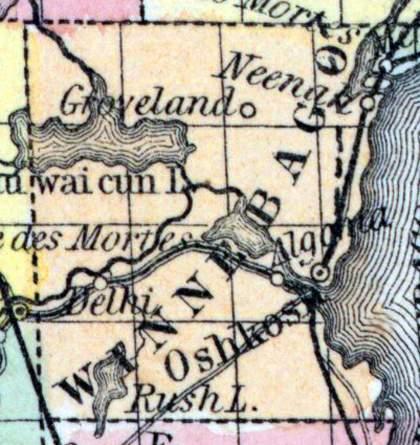WINNEBAGO COUNTY, situated toward the east part of Wisconsin, with Winnebago lake on the east, and other bodies of water in the Interior. Area, 500 square miles. Seat of justice, Oshkosh. Pop. in 1840, 135; in 1850, 10,167. (Fanning's, 1853)
WINNEBAGO, a county in the N. E. central part of Wisconsin, contains about 430 square miles. Lake Winnebago, from which the name is derived, bounds it on the E., and it is drained by the Neenah and Wolf rivers, navigable by steamboats. There are also several smaller lakes in the county. The surface is nearly level, and is diversified by prairies and tracts of timber; the soil is calcareous and very fertile. Wheat, Indian corn, oats, and lumber are the staples. In 1850 the county produced 57,072 bushels of wheat; 34,722 of corn, and 77,795 pounds of butter. It contained 2 newspaper offices, and 1798 pupils attending public schools. The rock found near the surface is limestone. A canal is in progress from the Neenah river to the Wisconsin, which will open steam navigation from Green Bay to the Mississippi. Several plankroads pass through the county, and a railroad is projected from Oshkosh to Milwaukee. Organized in 1842. Capital, Oshkosh. Population, 10,167. (Baldwin's New and Complete Gazetteer of the United States..., 1854)
WINNEBAGO, County, is bounded on the north by Outagamie, east by Calumet, (from which it is separated by Lake Winnebago), on the south by Fond du Lac, and on the west by Waushara and Marquette. It was set off from Fond du Lac and Brown counties, January, 1843. It was organized for county purposes, (its judicial connection being with Fond du Lac,) Feb. 20, 1842, and was fully organized Feb. 8, 1847. The seat of justice has been established at Oshkosh, near the entrance of Fox river (Neenah,) into Lake Winnebago. The surface of the county is generally level or slightly undulating, and well diversified with openings, prairie, marsh, timber, and springs of pure cold water. The soil produces all kinds of grain, and is well adapted to grazing. The county is comparatively new, and its agricultural advantages have never been fully developed. It is believed, however, that it will be more distinguished for its dairying, the growing of stock, and its manufactures, than for the raising of grain. The principal streams are the Fox and Wolf rivers. It is connected with the fourth judicial circuit, with the third congressional district, and constitutes the twenty-first senate district, and is divided into two assembly districts, viz: 1st. Towns 17 and 18, ranges 14, 15, 16 and 17. 2d. Towns 19 and 20, ranges 14, 15, 16 and 17. Population in 1840 was 135; in 1842,143; in 1846, 732; in 1847, 2,748; in 1850,10,167. County Officers for 1853 and 1854: Judge, Edwin Wheeler; Clerk of Court, E. E. Baldwin; Sheriff, Alex. F. David; Register, Edwin R. Rowley; Clerk of Board of Supervisors, J. H. Osborn; Treasurer, Jonathan Dougherty. (John Warren Hunt, Wisconsin Gazetteer..., Madison, 1853)

